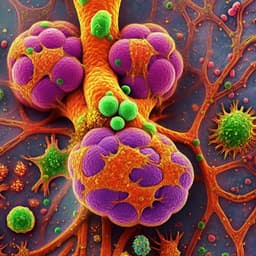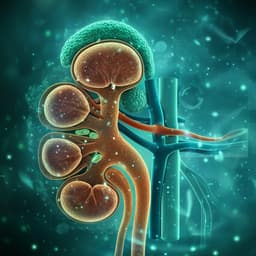
Medicine and Health
Molecular states during acute COVID-19 reveal distinct etiologies of long-term sequelae
R. C. Thompson, N. W. Simons, et al.
Explore the groundbreaking research that uncovers the distinct gene expression signatures linked to post-acute sequelae of SARS-CoV-2 infection, revealing connections with acute immune responses. This study was conducted by a team of experts at the Icahn School of Medicine at Mount Sinai.
~3 min • Beginner • English
Introduction
The study addresses why and how post-acute sequelae of SARS-CoV-2 infection (PASC, or long COVID) develop after acute COVID-19. PASC encompasses diverse, persistent symptoms such as fatigue, dyspnea, and smell/taste disturbances in a substantial fraction of survivors. Prior larger studies found little to no association between acute anti-spike antibody titers and later PASC, while lower total immunoglobulin levels predicted PASC, and multi-omic factors (viral RNAemia, EBV reactivation, specific T cell phenotypes, autoantibodies) were implicated. Hypotheses include chronic inflammation from viral persistence, autoimmunity, dysbiosis, and tissue damage. This work aims to comprehensively characterize acute whole-blood gene expression, at cell-type-specific resolution, that forecasts long-term PASC symptoms, testing whether distinct molecular etiologies are already evident during acute infection and how they relate to anti-spike antibody responses.
Literature Review
Recent larger-cohort studies interrogating PASC immunology reported: (1) no significant association between PASC and acute anti-spike antibody titers (IgG/IgA) in multiple cohorts; (2) decreased total acute antibody (e.g., IgM, IgG3) predicting PASC development; (3) associations of specific PASC subsets with acute measures including SARS-CoV-2 RNAemia, EBV presence, distinct CD8+ and CD4+ T cell phenotypes, and autoantibodies; and (4) post-acute autoantibodies associating with PASC. Proposed mechanisms linking acute COVID-19 to PASC include persistent viral reservoirs driving chronic inflammation, autoimmunity (including molecular mimicry and relaxation of B cell tolerance), microbiome/virome dysbiosis, and long-lasting tissue damage. These studies suggest heterogeneous risk factors but underscore the need to map acute host-response molecular processes that presage specific PASC outcomes.
Methodology
Cohort and sampling: 567 individuals were enrolled (495 hospitalized with COVID-19; 72 controls) in the Mount Sinai COVID-19 Biobank (April–June 2020). Serial blood draws were collected during hospitalization; controls provided one outpatient blood draw. Whole-blood RNA-seq was generated for 1,392 samples. Six months or more after discharge (median 363 days), 232 individuals completed a PASC symptom checklist; 165 of these had RNA-seq, contributing 361 acute-phase blood RNA-seq samples.
Serology: Anti–SARS-CoV-2 spike IgG, IgA, and IgM titers were measured by ELISA during acute illness. In an external validation dataset, anti-spike and total immunoglobulin subclass titers (e.g., total IgM, IgG3) were available.
Symptom assessment: A structured checklist queried new or worsened health issues (e.g., quality of life, sleep, lung problems, smell/taste, GI symptoms). Binary phenotypes were derived; items with n ≤ 5 positive among those with RNA-seq were excluded. Multiple responses across timepoints were collapsed as any-positive.
RNA-seq processing: Whole-blood RNA was extracted and sequenced (TruSeq Stranded Total RNA Library Prep Gold; NovaSeq 6000; ~50M paired-end reads/sample). Reads were aligned to GRCh38 with STAR and quantified at gene level with featureCounts. QC excluded samples with DV200 <80% or <10M mapped reads; globin genes were removed. Expression was normalized (edgeR TMM; voom with weights). Batch effects were addressed using mixed models and dedicated batch controls included across sequencing batches.
Cell-type deconvolution: CIBERSORTx with multiple references was evaluated; LM22 performed best based on correlations with clinical CBCs. Estimated cell-type fractions were used both as covariates and in interaction models.
Differential expression (DE): Linear mixed models (dream) were fit per gene for each PASC symptom, controlling for technical covariates, age, sex, COVID-19 severity at sampling, ICU admission, and selected cell-type fractions. To capture cell-type-specific (CTS) effects, an interaction term between symptom status and a given cell-type fraction was included. This tests for differences in the slope of expression versus cell fraction between symptom groups. To distinguish antibody titer–dependent versus –independent signals, models were re-fit controlling for log2 anti-spike IgG, IgA, and IgM titers. DE genes at FDR ≤ 0.05 were retained. GO term enrichment (one-sided Fisher tests with BH correction) annotated signatures.
Validation and robustness: The CTS interaction approach was validated in an independent COVID-19 single-cell RNA-seq cohort using pseudo-bulk models for acute-phase associations with 2–3 month PASC assessments, showing significantly higher correlations for matching cell type/symptom pairs. Titer-dependence inference was validated by stratifying samples into high versus low anti-spike titer strata and comparing correlations to full-data DE logFCs. Alternate models omitting covariates or controlling for single antibody classes yielded consistent results. Shared DEGs analyses quantified same- and opposite-direction overlaps across symptoms and cell types.
External validation of immunoglobulin findings: Using an independent cohort (n=134, 85 with PASC), logistic models replicated that lower total IgM and IgG3 (including interaction) predicted PASC independent of anti-spike IgA/IgG, and linear models showed the product IgM×IgG3 was lower with PASC (P=0.043) after controlling for anti-spike titers and clinical covariates.
Key Findings
- Acute anti-spike titers show limited association with PASC: In the Mount Sinai cohort, only sleep problems associated with acute anti-spike titers; most symptoms did not. Independent dataset confirmed no significant differences in acute anti-spike S1 IgA or IgG between PASC vs non-PASC (Mann–Whitney P ≥ 0.34).
- Cell-type-specific acute gene expression signatures predict PASC: Whole-blood DE without CTS interaction yielded no DEGs, but CTS interaction models revealed many significant DEGs across symptoms and cell types while controlling for cell composition and confounders.
- Plasma cell signatures define two etiologic clusters: (1) Pulmonary cluster (lung problems, pneumonia) with largely downregulated immunoglobulin-related genes; (2) Miscellaneous cluster (sleep problems, nausea/diarrhea/vomiting, skin rash, smell/taste problems) with upregulated immunoglobulin-related genes.
- Anti-spike titer–dependence distinguishes etiologies: Miscellaneous cluster DEGs (especially for sleep problems and nausea/diarrhea/vomiting) were largely anti-spike titer–dependent; controlling for anti-spike IgA/IgG/IgM abrogated plasma cell DEG signals and immunoglobulin-related GO enrichments. In contrast, pulmonary cluster DEGs and skin rash signatures were titer-independent.
- Opposite-direction overlaps between clusters: Plasma cell pulmonary and miscellaneous clusters shared significant opposite-direction DEGs, aligning with low co-occurrence of symptoms across clusters and supporting distinct etiologies.
- Additional CTS associations: CD8+ and γδ T cells associated with worse long-term quality of life; memory resting CD4+ T cells and neutrophils (reflecting negatively correlated fractions) with cavities/teeth problems; memory-activated CD4+ T cells with memory/thought problems; memory B cells (anxiety/depression) and M1 macrophages (need for supplemental O2) were largely titer-dependent.
- Validation of lower total immunoglobulins in PASC: In external data, lower acute total IgM and IgG3 titers (and their interaction) predicted PASC independent of anti-spike titers; linear modeling showed the product IgM×IgG3 was significantly lower in those who later developed PASC (P=0.043), supporting titer-independent downregulation of humoral activity underlying pulmonary symptoms.
- Findings not explained by severity or demographics: Maximum acute severity and ICU status were not significantly associated with most PASC symptoms; age and sex mostly not associated (except sex with hair loss).
Discussion
The study demonstrates that molecular features present during acute COVID-19 are linked to specific long-term sequelae, providing evidence that PASC originates, at least in part, from distinct acute host-response programs. Plasma cell biology appears central, with two divergent patterns: a titer-dependent increase in immunoglobulin-related gene expression associated with certain neuropsychiatric and mucocutaneous symptoms (miscellaneous cluster), and a titer-independent decrease in immunoglobulin-related expression associated with pulmonary sequelae. The former could reflect processes tied to the anti-spike response, including potential molecular mimicry or autoreactivity due to relaxed B cell tolerance. The latter suggests non-specific humoral deficiency or dysregulation that predisposes to persistent respiratory symptoms, consistent with literature linking antibody deficiencies to chronic pulmonary disease, and aligns with observed associations of PASC with autoantibodies that are independent of anti-spike titers. Beyond plasma cells, associations in monocytes, macrophages, CD8+ and CD4+ T cells suggest additional etiologies, possibly reflecting unresolved acute inflammation or immune dysregulation that contributes to specific symptom domains (e.g., dyspnea, cognition, oral health). Together, these results argue that PASC is heterogeneous, with multiple mechanistic pathways, and underscore the importance of capturing the acute phase in study designs to understand and predict long-term outcomes.
Conclusion
Acute whole-blood, cell-type-specific gene expression signatures reveal at least two distinct etiologies for PASC symptoms—one dependent on anti-spike antibody responses and another independent of them—already evident during hospitalization for COVID-19. Plasma cell signatures bifurcate symptoms into a pulmonary cluster with downregulated immunoglobulin-related genes (titer-independent) and a miscellaneous cluster with upregulated immunoglobulin-related genes (largely titer-dependent). External validation confirmed that lower total IgM and IgG3 associate with later PASC independently of anti-spike titers. These findings establish a direct link between acute host responses and long-term sequelae and suggest opportunities for early biomarker development and precision interventions. Future research should extend these analyses to non-hospitalized and asymptomatic infections, include precise infection timelines, incorporate post-acute molecular profiling, refine PASC phenotypes, and validate modeling approaches for CTS DE in larger cohorts.
Limitations
- PASC phenotypes were self-reported, potentially introducing reporting bias and selection bias in checklist completion.
- Cohort comprised exclusively hospitalized patients, limiting generalizability to milder or asymptomatic infections.
- Exact infection dates were unavailable, limiting control for timing within the acute disease course, especially for transient cell types like plasmablasts/plasma cells.
- The CTS interaction modeling approach, while validated, represents one of several possible strategies; further methodological evaluation is warranted.
- No post-acute molecular data were available in this dataset, precluding direct linkage of acute signals to post-acute molecular pathology.
- Power limitations for some cell type/symptom combinations mean identified DEGs likely represent a subset of true signals.
Related Publications
Explore these studies to deepen your understanding of the subject.







